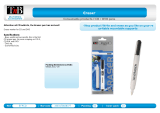
6 Using SMART Board Software in Projected Mode Macintosh Version
Using SMART Board Software in Projected Mode
You can run SMART Board software in one of two modes: Projected (Mouse) or
Non-Projected (Whiteboard) mode. Projected (Mouse) mode offers the most functionality at
the interactive screen. In fact, if you’re using a Rear Projection SMART Board interactive
whiteboard, a SMART Board for Flat-Panel Displays interactive overlay or a Sympodium
product, you must always keep SMART Board software in projected mode. And, of course, the
most effective way to use your SMART Board interactive whiteboard is with a connected digital
projector that displays the image from your computer on the interactive surface.
For information on the non-projected mode, see page 28 of this manual entitled Using SMART
Board Software in Non-Projected Mode.
1. Press and hold the SMART Board icon in the Dock and select Open Control Panel.
2. On the Boards tab, press the correct mode (Projected or Non-projected) and then
press OK.
Orienting the Screen
To accurately and appropriately respond to your touch, the SMART Board driver needs to
know exactly where the image from your computer is located on the interactive screen. The
driver gets this information from the screen’s orientation settings. With a correct orientation,
the cursor appears directly beneath your fingertip or the stylus of the Sympodium interactive
pen display, and the system accurately tracks screen contact.
Although SMART Board software assigns a default orientation to your interactive screen, you
can improve the screen’s response by performing an orientation procedure − a very simple
process of precisely touching red crosses (targets) on the screen. If your interactive
whiteboard gets jostled and the projected image becomes misaligned, you can repeat the
orientation procedure to correct the misalignment.
For even greater tracking precision, you can change the orientation level. Three levels are
available: Quick (4 points), Standard (9 points) and Fine (20 points). Depending on your
situation, you may want to re-orient quickly and with minimal interruption, or you may want to
obtain the most precise tracking level possible if you have a higher-resolution system.
When you change the orientation level, that level becomes the default for future orientations.
To change the mode
TIPS
To access the Orientation screen, press both the Right-Click and Keyboard
buttons on the pen tray.
During the orientation, firmly press the small yellow square in the center of
each red cross. If you neglect to do this, the SMART Board driver won’t track
your screen contact correctly.
If you’re dissatisfied with the precision of a particular orientation point, you can
retract the poorly aligned point by pressing the Right-Click or Keyboard
button, or the LEFT ARROW key on the keyboard.




















